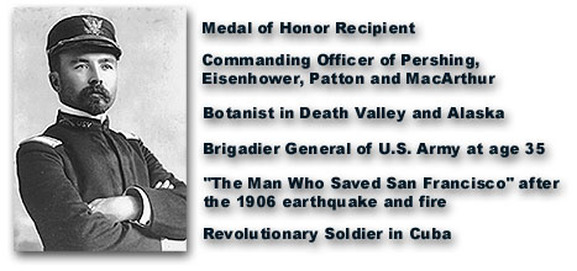
THE MAJOR GENERAL
General Funston, who was born in 1865 and who died in 1917, contributed significantly to the history of our country as a botanist in Death Valley and Alaska; as a revolutionary soldier in Spanish owned Cuba; and as Colonel of the 20th Kansas Volunteer Infantry in the Spanish American war. He received the Medal of Honor for his services in the Philippine Insurrection, and after his spectacular capture in 1901 of the Filipino revolutionary leader Aguinaldo, became a Brigadier General of the U.S. Army at age 35. He is known as “the man who saved San Francisco” after the great earthquake and fire of 1906. Ultimately he became a two-star General and the commanding officer of John J. Pershing, Dwight D. Eisenhower, George S. Patton, and Douglas MacArthur. At the time of his unexpected death of a heart attack at the age of 51 in 1917 shortly before the entry of the United States into World War I, Funston was the likely future commander of the American Expeditionary Force, a role which went to his subordinate Pershing.
General Funston, who was born in 1865 and who died in 1917, contributed significantly to the history of our country as a botanist in Death Valley and Alaska; as a revolutionary soldier in Spanish owned Cuba; and as Colonel of the 20th Kansas Volunteer Infantry in the Spanish American war. He received the Medal of Honor for his services in the Philippine Insurrection, and after his spectacular capture in 1901 of the Filipino revolutionary leader Aguinaldo, became a Brigadier General of the U.S. Army at age 35. He is known as “the man who saved San Francisco” after the great earthquake and fire of 1906. Ultimately he became a two-star General and the commanding officer of John J. Pershing, Dwight D. Eisenhower, George S. Patton, and Douglas MacArthur. At the time of his unexpected death of a heart attack at the age of 51 in 1917 shortly before the entry of the United States into World War I, Funston was the likely future commander of the American Expeditionary Force, a role which went to his subordinate Pershing.
Photos courtesy of Kansas State Historical Society

